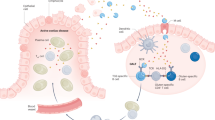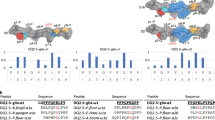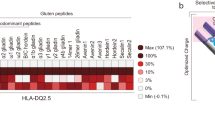Abstract
Celiac disease (CD) is an increasingly diagnosed enteropathy (prevalence, 1:200–1:300)1 that is induced by dietary exposure to wheat gliadins2 (as well as related proteins in rye and barley) and is strongly associated with HLA-DQ2 (α1*0501, β1*0201), which is present in over 90% of CD patients3. Because a variety of gliadin peptides have been identified as epitopes for gliadin-specific T-cell clones4,5,6 and as bioactive sequences in feeding studies and in ex vivo CD intestinal biopsy challenge7,8,9, it has been unclear whether a ‘dominant’ T-cell epitope is associated with CD. Here, we used fresh peripheral blood lymphocytes from individual subjects undergoing short-term antigen challenge and tissue transglutaminase-treated, overlapping synthetic peptides spanning A-gliadin to demonstrate a transient, disease-specific, DQ2-restricted, CD4 T-cell response to a single dominant epitope. Optimal gamma interferon release in an ELISPOT assay was elicited by a 17-amino-acid peptide corresponding to the partially deamidated peptide of A-gliadin amino acids 57–73 (Q65E). Consistent with earlier reports indicating that host tissue transglutaminase modification of gliadin enhances gliadin-specific CD T-cell responses10, tissue transglutaminase specifically deamidated Q65 in the peptide of A-gliadin amino acids 56–75. Discovery of this dominant epitope may allow development of antigen-specific immunotherapy for CD.
This is a preview of subscription content, access via your institution
Access options
Subscribe to this journal
Receive 12 print issues and online access
$209.00 per year
only $17.42 per issue
Buy this article
- Purchase on Springer Link
- Instant access to full article PDF
Prices may be subject to local taxes which are calculated during checkout





Similar content being viewed by others
References
Hin, H., Bird, G., Fisher, P., Mahy, N. & Jewell, D. Coeliac disease in primary care: case finding study. Br. Med. J. 318, 164–167 (1999).
Kendall, M., Schneider, R., Cox, P. & Hawkins, C. Gluten subfractionation in coeliac disease. Lancet 2, 1065–1067 (1972).
Sollid, L.M., Thorsby, E. HLA susceptibility genes in celiac disease: genetic mapping and role in pathogenesis. Gastroenterol. 105, 910–922 (1993).
Molberg, O. et al. Gliadin specific, HLA DQ2-restricted T cells are commonly found in small intestinal biopsies from coeliac disease patients, but not from controls. Scand. J. Immunol. 46, 103–109 (1997).
van der Wal, Y. et al. Selective deamidation by tissue transglutaminase strongly enhances gliadin-specific T cell reactivity. J. Immunol. 161, 1585–1588 (1998).
Sjostrom, H. et al. Identification of a gliadin T-cell epitope in coeliac disease: general importance of gliadin deamidation for intestinal T-cell recognition. Scand. J. Immunol. 48, 111–115 (1998).
Mantzaris, G. & Jewell, D. In vivo toxicity of a synthetic dodecapeptide from A gliadin in patients with coeliac disease. Scand. J. Gastroenterol. 26, 392–398 (1991).
de Ritis, G. et al. In vitro (organ culture) studies of the toxicity of specific A-gliadin peptides in celiac disease. Gastroenterology 94, 41–49 (1988).
Mauri, L. et al. In vitro activities of A-gliadin-related synthetic peptides. Scand. J. Gastroenterol. 31, 247–253 (1996).
Molberg, O. et al. Tissue transglutaminase selectively modifies gliadin peptides that are recognized by gut-derived T cells in celiac disease. Nature Med. 4, 713–717 (1998).
Kasarda, D. et al. Nucleic acid (cDNA) and amino acid sequence of α-type gliadins from wheat (Tricetum aestivum). Proc. Natl. Acad. Sci. USA 81, 4712–4716 (1984).
Gutgemann, I., Fahrer, A., Altman, J., Davis, M. & Chien, Y-h. Induction of rapid T cell activation and tolerance by systemic presentation of orally administered antigen. Immunity 8, 667–673 (1998).
Greenbergm, C.S., Birckbichlerm, P. & Ricem, R. Transglutaminases: multifunctional cross-linking enzymes that stablize tissues. FASEB J. 5, 3071–3077 (1991).
Lehmann, P.V., Forsthuber, T., Miller, A. & Serzarz, E.E. Spreading of T-cell autoimmunity to cryptic determinants of an autoantigen. Nature 359, 155–157 (1992).
Moskophidis, D., Lechner, F., Pircher, H. & Zinkernagel, R. Virus persistence in acutely infected immunocompetent mice by exhaustion of antiviral cytotoxic effector T cells. Nature 362, 758–761 (1993).
Lahat, N. et al. Cytokine profile in coeliac disease. Scand. J. Immunol. 49, 441–446 (1999).
Vartdal, F. et al. The binding motif of the disease associated HLA-DQ (α1*0501, β1*0201) molecule. Eur. J. Immunol. 26, 2764–2772 (1996).
Ward, R. Codex alimentarius- the proposed gluten-free standard (position paper) (The Coeliac Society of the United Kingdom, High Wycombe, UK, 1999).
Bunce, M. et al. Phototyping: comprehensive DNA typing for HLA-A, B, C, DRB1, DRB3, DRB4, DRB5 & DQB1 by PCR with 144 primer mixes utilizing sequence-specific primers (PCR-SSP). Tissue Antigens 46, 355–367 (1995).
Olerup, O., Aldener, A. & Fogdell, A. HLA-DQB1 and DQA1 typing by PCR amplification with sequence-specific primers in 2 hours. Tissue Antigens 41, 119–134 (1993).
Mullighan, C.G., Bunce, M. & Welsh, K.I. High-resolution HLA-DQB1 typing using the polymerase chain reaction and sequence-specific primers. Tissue Antigens. 50, 688–692 (1997).
Plebanski, M. et al. Protection from Plasmodium berghei infection by priming and boosting T cells to a single class I restricted epitope with recombinant carriers suitable for human use. Eur. J. Immunol. 28, 4345–4355 (1998).
Acknowledgements
We thank A. Willis for HPLC and amino-acid analysis; G. Bird and H. Griffith for assays of antibody against endomysium; M. Bunce for tissue typing; A. Pathan and A. Lalvani for the gift of antibodies against class II; A. Connell for dietary advice; and J. Simmons and A. Ellis for referring subjects for the study. R.P.A. was supported by a CJ Martin/Menzies Fellowship from the National Health and Medical Research Council of Australia 987001. A.V.S.H. is a Wellcome Trust Principal Research Fellow. The work was supported by the Coeliac Society of the United Kingdom and Isis Innovation (University of Oxford, UK).
Author information
Authors and Affiliations
Corresponding author
Rights and permissions
About this article
Cite this article
Anderson, R., Degano, P., Godkin, A. et al. In vivo antigen challenge in celiac disease identifies a single transglutaminase-modified peptide as the dominant A-gliadin T-cell epitope. Nat Med 6, 337–342 (2000). https://doi.org/10.1038/73200
Received:
Accepted:
Issue Date:
DOI: https://doi.org/10.1038/73200
This article is cited by
-
Activated gut-homing CD8+ T cells for coeliac disease diagnosis on a gluten-free diet
BMC Medicine (2021)
-
Circulating CD103+ γδ and CD8+ T cells are clonally shared with tissue-resident intraepithelial lymphocytes in celiac disease
Mucosal Immunology (2021)
-
The evaluation of part-baked frozen bread produced from wheat flour and guar gum in the diet of celiac patients
Journal of Food Science and Technology (2021)
-
T cell receptor cross-reactivity between gliadin and bacterial peptides in celiac disease
Nature Structural & Molecular Biology (2020)
-
Distinct phenotype of CD4+ T cells driving celiac disease identified in multiple autoimmune conditions
Nature Medicine (2019)



